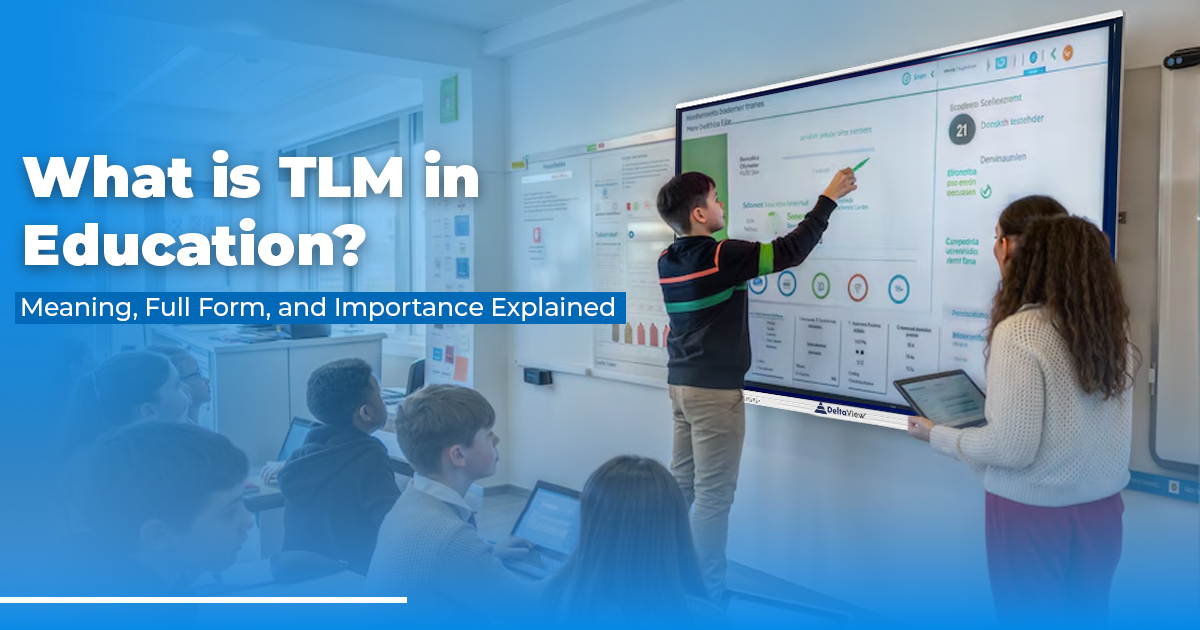What is TLM in Education? Meaning, Full Form, Why it Matters
May 8, 2025
In today’s classrooms, teaching goes beyond just delivering information. It’s about how students engage with and understand what they’re learning. One powerful way educators achieve this is through TLM, or Teaching-Learning Materials. These materials make learning more interactive, engaging, and impactful.
At DeltaView Learn, we believe that when teaching tools are thoughtfully integrated into lessons, they can make a real difference in how students grasp and retain knowledge. Let’s dive into what TLM means, its full form, the different types, and why it plays such a crucial role in education today.
What is TLM?
TLM stands for Teaching-Learning Material resources that help teachers explain concepts more clearly and help students better understand the material. TLMs can be as simple as a set of flashcards or as advanced as a digital simulation. Whether it’s a classroom chart, a video on the water cycle, or a hands-on science experiment, TLMs make learning more engaging and relatable.
Full Form of TLM: Teaching-Learning Material
As the name suggests, Teaching-Learning Materials support both teaching and learning. These resources can be visual, auditory, tactile, or even digital, ensuring that different learning styles are catered for. This variety helps ensure that every student is reached.
Types of Teaching-Learning Materials
To use TLMs effectively, it helps to understand the main categories:
1. Visual TLMs
These materials help students visualize concepts:
- Charts, graphs, and maps
- Pictures, illustrations, and smart board
Visual aids are especially useful for students who learn best through seeing information.
2. Audio TLMs
Great for auditory learners who learn by listening:
- Recorded lessons, language tapes, audiobooks, and podcasts
These tools help reinforce spoken instructions and can be especially useful in language learning.
3. Audio-Visual TLMs
These combine sight and sound for a richer learning experience:
- Educational videos, interactive animations, and narrated slideshows
Using multiple senses at once can boost student engagement and retention.
4. Tactile/Manipulative TLMs
These are hands-on materials that students can touch and explore:
- Math kits, science experiment sets, and human body models
Tactile materials work best for kinesthetic learners who understand best through physical activity.
Why TLM is Important in Education
Teaching-Learning Materials do more than just make lessons interesting they truly transform how student learn. Here’s why they matter:
1. Boost Engagement
When students interact with materials, learning becomes active, keeping them engaged and involved.
2. Simplify Complex Concepts
TLMs break down difficult ideas into digestible, understandable pieces especially useful for complex subjects like math and science.
3. Cater to Different Learning Styles
Every student learns differently. TLM offer a variety of formats (visual, auditory, tactile) to suit different learning preferences.
4. Encourage Creativity and Critical Thinking
TLMs like role-play kits or problem-solving activities encourage students to think creatively and apply their knowledge in new ways.
5. Improve Retention
Students remember information better when they can see, hear, and manipulate it. Using multiple senses strengthens memory.
6. Support Inclusive Education
For students with disabilities or learning challenges, TLMs can be adapted think Braille charts, large-print books, or audio materials to meet specific needs.
Benefits of Using TLMs in the Classroom
At DeltaView Learn, we’ve seen how the right materials can transform classrooms. Here are some key benefits:
- Makes Learning Fun: TLMs add variety and excitement to lessons, moving away from monotony.
- Clarifies Concepts: Visuals and hands-on tools help teachers communicate ideas more effectively.
- Bridges Theory and Practice: TLMs connect textbook knowledge with real-world applications.
- Inspires Motivation: Engaging materials spark curiosity and encourage students to learn more.
Examples of TLMs Across Subjects
Here’s how TLMs can be used in various subjects:
- Science: Microscope kits, anatomy models, lab tools
- Math: Geometric shapes, fraction discs, measuring instruments
- Language: Phonics charts, word cards, role-play storyboards
- Social Studies: Timelines, globes, historical maps, cultural artifacts
The Rise of Digital TLMs
Technology has expanded the world of TLMs. Today’s digital tools include:
- Online quizzes and learning apps
- Virtual simulations and AR/VR content
- Interactive smartboards and LMS platforms
These tools are especially beneficial for remote or blended classrooms, offering flexible learning options.
Involving Students in Creating TLMs
One powerful approach is getting students involved in creating their own learning materials. When students design posters, build models, or collaborate on group projects, they:
- Gain a deeper understanding of the material
- Learn collaboration and teamwork
- Take ownership of their learning process
Teachers also benefit they can tailor TLMs to be age-appropriate, goal-oriented, and connected to real-life scenarios.
Challenges and Solutions
Despite the many benefits, there are some challenges:
1. Limited Resources
Solution: Get creative with DIY materials or use recycled items. Schools can also look for support from government or NGO programs.
2. Time Constraints
Solution: Incorporate TLMs into lesson plans regularly, so they become a natural part of teaching.
3. Lack of Training
Solution: Teacher training is essential. At DeltaView Learn, we offer workshops to help educators confidently use and create their own TLMs.
Conclusion
Incorporating Teaching-Learning Materials into your lessons can completely change the way students engage with and understand their studies. Whether it’s improving engagement, simplifying difficult topics, or supporting an inclusive classroom, TLMs are key to quality education.
At DeltaView Learn, we’re committed to providing teachers with innovative TLM resources that spark curiosity and encourage deeper learning. When educators are equipped with the right tools, students succeed.
Ready to take your teaching to the next level? Explore our TLM resources and educator workshops today.